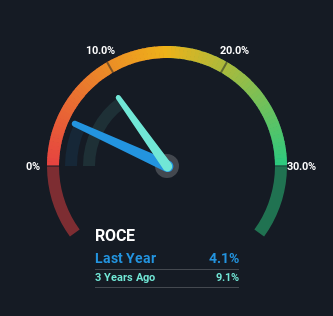Did you know there are some financial metrics that can provide clues of a potential multi-bagger? Amongst other things, we'll want to see two things; firstly, a growing return on capital employed (ROCE) and secondly, an expansion in the company's amount of capital employed. If you see this, it typically means it's a company with a great business model and plenty of profitable reinvestment opportunities. In light of that, when we looked at Pollard Banknote (TSE:PBL) and its ROCE trend, we weren't exactly thrilled.
What Is Return On Capital Employed (ROCE)?
If you haven't worked with ROCE before, it measures the 'return' (pre-tax profit) a company generates from capital employed in its business. To calculate this metric for Pollard Banknote, this is the formula:
Return on Capital Employed = Earnings Before Interest and Tax (EBIT) ÷ (Total Assets - Current Liabilities)
0.041 = CA$20m ÷ (CA$605m - CA$115m) (Based on the trailing twelve months to September 2024).
Therefore, Pollard Banknote has an ROCE of 4.1%. In absolute terms, that's a low return and it also under-performs the Hospitality industry average of 11%.
See our latest analysis for Pollard Banknote

Above you can see how the current ROCE for Pollard Banknote compares to its prior returns on capital, but there's only so much you can tell from the past. If you'd like, you can check out the forecasts from the analysts covering Pollard Banknote for free.
The Trend Of ROCE
When we looked at the ROCE trend at Pollard Banknote, we didn't gain much confidence. Around five years ago the returns on capital were 11%, but since then they've fallen to 4.1%. Meanwhile, the business is utilizing more capital but this hasn't moved the needle much in terms of sales in the past 12 months, so this could reflect longer term investments. It may take some time before the company starts to see any change in earnings from these investments.
The Bottom Line
Bringing it all together, while we're somewhat encouraged by Pollard Banknote's reinvestment in its own business, we're aware that returns are shrinking. Since the stock has gained an impressive 51% over the last five years, investors must think there's better things to come. Ultimately, if the underlying trends persist, we wouldn't hold our breath on it being a multi-bagger going forward.
Pollard Banknote does have some risks though, and we've spotted 2 warning signs for Pollard Banknote that you might be interested in.
While Pollard Banknote may not currently earn the highest returns, we've compiled a list of companies that currently earn more than 25% return on equity. Check out this free list here.
New: Manage All Your Stock Portfolios in One Place
We've created the ultimate portfolio companion for stock investors, and it's free.
• Connect an unlimited number of Portfolios and see your total in one currency
• Be alerted to new Warning Signs or Risks via email or mobile
• Track the Fair Value of your stocks
Have feedback on this article? Concerned about the content? Get in touch with us directly. Alternatively, email editorial-team (at) simplywallst.com.
This article by Simply Wall St is general in nature. We provide commentary based on historical data and analyst forecasts only using an unbiased methodology and our articles are not intended to be financial advice. It does not constitute a recommendation to buy or sell any stock, and does not take account of your objectives, or your financial situation. We aim to bring you long-term focused analysis driven by fundamental data. Note that our analysis may not factor in the latest price-sensitive company announcements or qualitative material. Simply Wall St has no position in any stocks mentioned.
About TSX:PBL
Pollard Banknote
Manufactures and sells lottery and charitable gaming products and solutions in the United States, Canada, and internationally.
Undervalued with reasonable growth potential.
Similar Companies
Market Insights
Community Narratives




